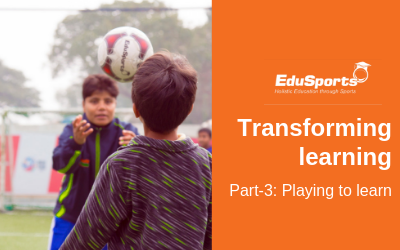“To succeed is to have failed” – learning from failures

Education – the amazingly unique “business”!
Over the last 4 years, I have had the good fortune of spending quality time with nearly 500 school leaders personally, many education service providers with longer experience in the space and in the process, getting to understand the K-12 education system in India.
I have been amazed at how unique the Education “business” is. Here are some of the aspects that I found unique:
1) Is it a business? or is it a social service?: Government regulation requires K-12 schools to be run as Trusts. Most (not all) schools are run like a business with an operating “service company” model to handle the not-for-profit Trust related regulation. Yes, not-for-profit does not mean zero-cost and that it has to keep making losses. In the process, many school leaders are doing a tough balancing act between behaving like a business and doing social good. Many service providers make a pitch to the school as a business (“Hey, we charge X. You charge parents X + 25%!”) as against a pitch around improving the quality of education being provided. 2) No more high moral ground:In this balance between business and social service, Parents are increasingly seeing the school as another business; another provider of a service that they buy. As against almost feeling obliged that the organisation is taking efforts to educate their kids at a reasonable cost. And in the process, schools are losing the high moral ground that they had in dealings with parents. As a result of this, many well-meaning schools are struggling to introduce new initiatives that involve some additional expense. The trust deficit between the parents and the school shows up at such times and hurts everyone in the system – especially the children. 3) Inadequate good quality talent available: Once schools lose the high moral ground, so do the folks associated with the organisation. With the social standing of being a teacher getting diluted, schools are having trouble finding good quality talent. Earlier, the respect that a teacher got in the community, probably, compensated for the lower pay package. Once money – and not social good – becomes the primary attraction for taking up a teaching job, the potential teaching community has many other better paying options. But again, most business continue to invest in good quality talent because it has a direct impact on the quality of service – as perceived by the consumer or the customer. 4) The consumer of the service is not the customer: My child “consumes” the “service” of the school. I pay the bill and am the customer. My child is the consumer. I do not directly experience the service & therefore cannot course-correct. So, teacher quality is not something I can give direct feedback on. (And maybe, this is why most schools emphasise the “infrastructure” – IT enabled classrooms, sports facilities, maths/english labs etc. And not the quality of teachers) 5) The consumer of the service does not know what is good quality: My child does not know what is “good quality” in Education. And given the power equation, has very little say in demanding good quality. The only way the customer (parent) can check is to keep spending time with the child – and of course, see the year-end exam results. 6) The customer also does not know what is good quality: Firstly, the service delivery process is completely opaque. How many parents have actually seen a teacher teach their child? In PTMs, only the Principal or Vice-Principal speaks publicly. The teachers are only trusted to speak to the parents in a one-on-one manner and on very specific issues like “Your child is good at Maths” “Your child is very well behaved”. Stuff for which you have no counters as the experience is one-sided. The parent is not an educationist who knows exactly what, how and when a child should be learning. And beyond the 1st or 2nd standard, most parents will not be able to judge whether the child is learning the right things and learning them well. This is true for academics more than co-scholastic. In sports, art, music etc, most parents believe they know more than the school! 7) The assessment of good quality is done by the provider: The person who teaches my child sets the exams, corrects the paper and gives the marks. So, if my child gets 98%, my child and I feel we are getting good quality. The parent does not have any independent means to judge the quality. Again, in co-scholastic areas, parents are able to judge by just observing their child dance better or play better. Not always true for academics as parents might not be qualified to judge improvement. Hence exam results as the only barometer. 8) No after-sales support: Firstly, after-sales support kicks in when there is a clear case of poor quality in delivery. That itself is a challenge in the Education business context. In case your child gets poor results, there is no after-sales support. In many cases, as a parent, you will be told that your kid is not paying attention in class, you are not spending enough time after-school supporting the child etc. The after-sales support is some condescending advice that you need to do more work! 9) No benchmarks of of good quality: Till 10th grade or 12th grade, all assessments are limited to the school. Only in 10th or 12th do the students realize where they stand wrt the larger student population. And it is too late to do anything by then. Refer point above about after-sales support. 10) High switching costs. Therefore high “ARPU – average revenue per user”: Apart from the registration fees charged by the school that hinder switching, many other factors add to the high switching costs experienced by the customer. E.g. Kids make friends in schools; the school is located nearby; the other schools – of the same Board – do not have vacancies etc. This translates into a lot of grumbling when fees are hiked – but everybody lines up to pay them. And so, high and predictable ARPUs over a 10-12 year period. 11) High entry barriers:The process for getting permission to set up a school is not trivial. Also, a school setup is capital intensive unless you have the political/real-estate leverage to get low-cost land for the school in a decent location. Else, like some of the schools we work with, it takes decades to grow from a “I started with a few children coming to my home” to a 1000 child school with its own infrastructure. 12) Never ending demand: Majority of kids will always go to school (assuming their parents can afford it) – in spite of MOOCs, home-schooling and all other ideas. And there are many, many more kids coming in the years ahead. 13) The consumer has no voice. The person most affected by all the points above and the decisions taken by the parent, teachers, Principals, government etc is the child. And the child has no say in any of these matters. 14) The consumer is not interested in the service! Children do not want to go to school. Parents want their kids to go to school. 🙂 And hence, the whole pontification around “Do you know how hard your parents are working to send you to school? And you are wasting your time having fun instead of studying hard!” does not work. Am sure the kids are thinking “But I did not want to come here in the first place!”. Since the consumer is not interested in the service in the first place, behaviors like demanding quality; making the most of the opportunity etc are not designed into the system.If the consumer (the child) had the choice, there would be no schools at all! 🙂 There is another school of thought that has data to prove that kids learn better by themselves (but that’s the subject of another post)
I can’t think of many other businesses that have such unique characteristics. Many of these factors will not change in a hurry – regulation, parent activism or otherwise.
In summary, the Education business sounds like a combination of:1) A social enterprise (Balancing profits with a positive social impact)
2) A monopoly enterprise (Poor customer choice. High entry barriers. High switching costs)
The ideal combination is to leverage the monopoly characteristics for a larger inherently positive social impact. But for each school, the combination will be unique. And each school promoter has to make that choice.

Author,
Saumil Majmudar,
Co-founder and CEO, EduSports







